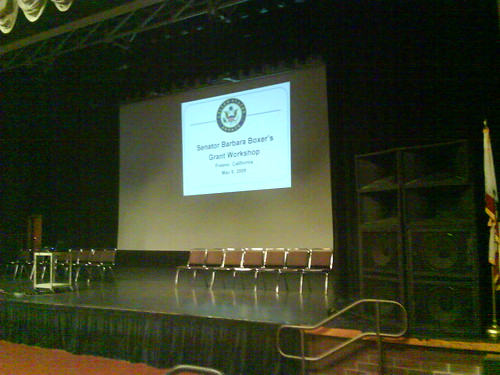The cell phone is perceived as something that has practical and entertainment value. Even people who can't afford much can get a cell phone. The same can't be said about the computer. Many don't see the computer as a high priority and not an investment they can afford. In situations where it is a choice between a car and a computer, the computer is not always the top priority. The cell phone has a practical advantage as a way to communicate and also entertain. Now phones are coming out with the same praticality of a desktop computer.
The
IPhone is the answer to that, now they get the entertainment and the information all in one device. The entertainment piece brings them to the pratical piece of a way to communicate and gather information. The cell phone will be the major communication device that will help bridge the digital divide. The
IPhone is the first major step.
Now libraries must think of ways to engage using the cell phone. Library elf is one (even though it is not a library service, but an ad supported agency that runs it), twitter and jaiku are other ways. Find a way to notify library activities, collections, and reference by cell phone. This is the future. It will get easier over time and it won't be so expensive to text nor will it be restricted to just text.
Here are some articles:
Is It Time To Call It Quits On The PC?
http://techdirt.com/articles/20070430/072706.shtml
With Vista having failed to ignite a boom in the computer industry, some analysts are starting to turn dour on the future of the PC. David Daoud, an analyst at IDC, thinks it's time for computer makers to rethink the traditional PC, and to work on developing more innovative products. He notes that the basic PC (with its big monitor and QWERTY keyboard) has basically been the same since its inception, and that things like ultra mobile PCs, tablets and other forms that have yet to be invented will come to play an important part role in the industry. Of course, people have been talking about all of these things before, and despite grandiose ambitions, nothing has made a dent in the market. The latest, the ultra mobile PC (UMPC) has pretty much been a dud, despite plenty of backing and hype. This isn't to say that manufacturers shouldn't be exploring alternatives, but as Apple has shown with its resurgent computer business, there's plenty of room for innovation and growth within the traditional confines of the PC.
END SNIP
AND
Mobile minitablets still grounded despite new tech
http://news.com.com/2100-1041_3-6180026.html?part=rss&tag=2547-1_3-0-5&subj=news
By Tom Krazit
Staff Writer, CNET News.com
Published: April 30, 2007, 4:00 AM PDT
PDAs (personal digital assistants) are pretty much dead; smart phones are the domain of the cellular industry; and the newest push, the ultramobile PC, hasn't met with much early success. Of course, new technology isn't always embraced by the masses, especially when it's expensive and people don't understand why they need it.
....
Yet, mobile smart phones are precisely where Intel's eyes are trained. "When you look at the high end of the smart-phone category, that will likely get replaced by the UMPC," Chandrasekher said in comments after his keynote speech in Beijing.
A lot of dominoes will have to fall in the right places for that to happen: Intel will have to deliver its low-power chips, get its hardware partners to build compelling devices, convince developers to write software with a mobile experience in mind, and figure out a way to deliver an always-on Internet connection. And the final product has got to cost around $400.
END SNIP
I didn't know the ultra-mobile PC would be such a bust. Probably just as successful as the sony reader, and now the
Dell Axim. (I own a dell axim. In my opinion, this is the best alternative to a smart phone if you don't want a RIDICULOUS phone bill, wi-fi is free.) People want technology in their pocket and there has to be incentive in using it beyond just practical applications, like doing homework or working on a resume. People make purchases largely based on entertainment. So when a practical product comes out that looks like entertainment, good things can happen.
SNIP
Over a year ago, Microsoft began the big move to put the poor online via cell phone:
Microsoft Would Put Poor Online by Cellphone
By JOHN MARKOFF
Published: January 30, 2006
http://www.nytimes.com/2006/01/30/technology/30gates.html
Craig J. Mundie, Microsoft's vice president and chief technology officer, said in an interview here that the company was still developing the idea, but that both he and Mr. Gates believed that cellphones were a better way than laptops to bring computing to the masses in developing nations. "Everyone is going to have a cellphone," Mr. Mundie said, noting that in places where TV's are already common, turning a phone into a computer could simply require adding a cheap adaptor and keyboard. Microsoft has not said how much those products would cost.
END SNIP
Of course, not sure if Microsoft ever came out with something. Steve Jobs must of understood the same thing, since he pushed the product faster.
Why Apple shifted coders to iPhone
Written by Om Malik
Thursday, April 12, 2007 at 6:37 PM PT
http://gigaom.com/2007/04/12/why-apple-shifted-coders-to-iphone/
Anyone looking for proof of the strategic importance of iPhone to Apple doesn’t have to look beyond Apple’s
press release page — the company is delaying the next version of its Operating System, code-named Leopard, by four months, and instead shifting resources to iPhone, now slated for late June 2007 release.
END SNIP
He will make more money on the IPhone than on any other product Apple could put out this year. Once a new version comes out, the masses will really have access to this powerful device. Of course,
power may still be an issue. We don't have to wait for the IPhone to stay connected either.
Social Networking Leaves Confines of the Computer
By BRAD STONE and MATT RICHTEL
Published: April 30, 2007
http://www.nytimes.com/2007/04/30/technology/30social.html?ex=1335672000&en=980ae5cc2c0428b9&ei=5124&partner=permalink&exprod=permalink
The social networking phenomenon is leaving the confines of the personal computer. Powerful new mobile devices are allowing people to send round-the-clock updates about their vacations, their moods or their latest haircut.
New online services, with names like Twitter, Radar and Jaiku, hope people will use their ever-present gadget to share (or, inevitably, to overshare) the details of their lives in the same way they have become accustomed to doing on Web sites like MySpace.
END SNIP
This becomes critical because it is another avenue businesses, organizations, and libraries need to get into to get to their users. The cell phone is taking over the laptop and the pc and to get the message across, we need to go there too. This is why the use of
twitter becomes important. People can be just as connected to your organization and what it is doing as they are connected to their friends. They can see the benefits of what you have to offer through a free subscription service.
The future of computing is online and mobile. I never thought I would see the laptop as the heavy one. I remember teaching classes about computer stating the advantages of the laptop is its mobility. Things are changing.
Ultramobile Geek:How much mobile internet do you need?
http://www.ultramobilegeek.com/2007/05/how-much-mobile-internet-do-you-need.htmlA doctor can take his smartphone with him everywhere and have his schedule of upcoming appointments at hand and get text messages, Email, and reminders without added bulk. However, a doctor on call may want an ultra-mobile PC to carry around encrypted patient histories and pull them up on demand.
END SNIP
The article categorizes the laptop as large and heavy. Not as mobile as a smart phone which looks like the way things are going.
Lastly:
Seeing No Progress, Some Schools Drop Laptops
http://www.nytimes.com/2007/05/04/education/04laptop.html?ex=1336017600&en=0da7ad13de3693ef&ei=5124&partner=permalink&exprod=permalink
Yet school officials here and in several other places said laptops had been abused by students, did not fit into lesson plans, and showed little, if any, measurable effect on grades and test scores at a time of increased pressure to meet state standards. Districts have dropped laptop programs after resistance from teachers, logistical and technical problems, and escalating maintenance costs.
Such disappointments are the latest example of how technology is often embraced by philanthropists and political leaders as a quick fix, only to leave teachers flummoxed about how best to integrate the new gadgets into curriculums. Last month, the United States Department of Education released a study showing no difference in academic achievement between students who used educational software programs for math and reading and those who did not.
Those giving up on laptops include large and small school districts, urban and rural communities, affluent schools and those serving mostly low-income, minority students, who as a group have tended to underperform academically.
Matoaca High School just outside Richmond, Va., began eliminating its five-year-old laptop program last fall after concluding that students had failed to show any academic gains compared with those in schools without laptops. Continuing the program would have cost an additional $1.5 million for the first year alone, and a survey of district teachers and parents found that one-fifth of Matoaca students rarely or never used their laptops for learning. “You have to put your money where you think it’s going to give you the best achievement results,” said Tim Bullis, a district spokesman.
END SNIP
We see this in our library too. Many students wasting too much time on Myspace instead of getting their assignments done. Of course, when they are short on time, they pull the old "I am a student working on a research project, can I get more time?"
Some advice to not get too deep into the next new technology. Yes we need to keep up, but going too far can just end up blowing up in your face. The right piece of technology at the right time can connect with your users or blow them away. It is more the analysis of how effective an organization can be in making the connection using web 2.0 products. In most cases, it can't trump traditional services, especially in rural areas. The cell phone has its advantage, but knowing how to make the right connection is much more difficult than just dumping rss feeds into twitter.





![Reblog this post [with Zemanta]](http://img.zemanta.com/reblog_e.png?x-id=dd67dac5-5836-4342-8985-87d0961362f6)

